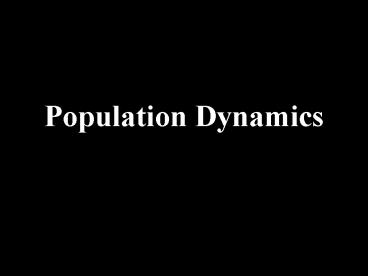Population Dynamics PowerPoint PPT Presentation
1 / 16
Title: Population Dynamics
1
Population Dynamics
2
Population Dynamics
- Populations tend to grow to the maximum extent
possible given environmental conditions - Biotic potential
- Dependent on innate biological principles
3
Not Sustained
- Biotic potential cannot be sustained
- Environmental resistance
- Population curves
4
J-Curve
- Density independent
- Results from sudden crash in population size
- Outstrip resource limit
- catastrophe
5
Sigmoid Curve
- Density dependent
- Recycling and renewal of resources
- Establishes equilibrium around carrying capacity
6
Sigmoid Curve
- A lag phase
- B acceleration phase
- C exponential growth
- D deceleration phase
- E equilibrium
- G dynamic fluctuations
7
Dynamic Fluctuation Phase
- Most populations
- Density- dependent factors
- Intraspecific competition
- Predation
- disease
8
Mortality and Birthrate vs. Density
- Mortality increases as density increases
- Birthrate is density dependent
- K equilibrium point
- r recruitment or growth
9
Growth and Density
- n density at which maximum growth occurs
- Used for management of wild game populations
10
Predator- Prey Effect
- Delayed density dependence
11
Survivorship Curve
- Type I large animals immune to predation, live
to old age - Type II mostly prey, predation is constant
throughout lifespan - Type III large numbers of young because most
will be eaten, only few adults survive
12
Reproductive Patternsr- selected vs K-selected
- r-selected
- Reproduce early and put most of their energy into
reproduction - Many small offspring
- High growth rate Population size fluctuates
wildly around carrying capacity - Low ability to compete
- Most offspring die before reaching reproductive
age
- K-selected
- Fewer, larger offspring
- High parental care
- Most offspring survive to reach reproductive age
- Lower growth rate
- High ability to compete
- Population size fairly stable around carrying
capacity
13
Factors that Influence Population Dynamics
- Positive enhance population growth
- Negative reduce population growth
14
Symbiotic Relationships
- Can be positive or negative
- Lichens
- Coral and zooxanthelae algae
- Wood termites and protozoa
- Humans and gut flora
15
Behavior Patterns
- Can be positive or negative
- Migration
- Territory behavior
- Societies and hierarchies
- Mating and courtship
- Colors, patterns, physical characteristics
16
Biological Controls
- Predators
- Diseases
- Pheromones

